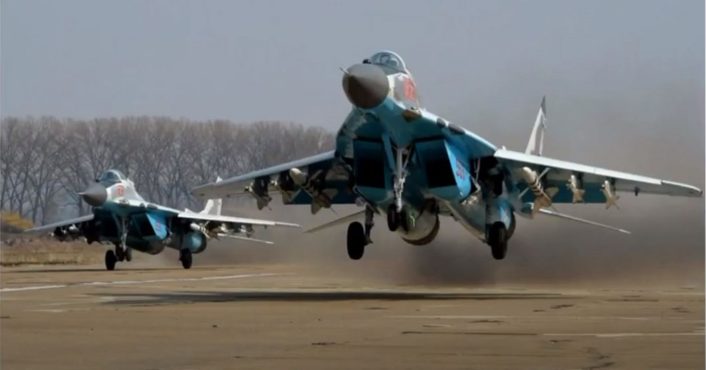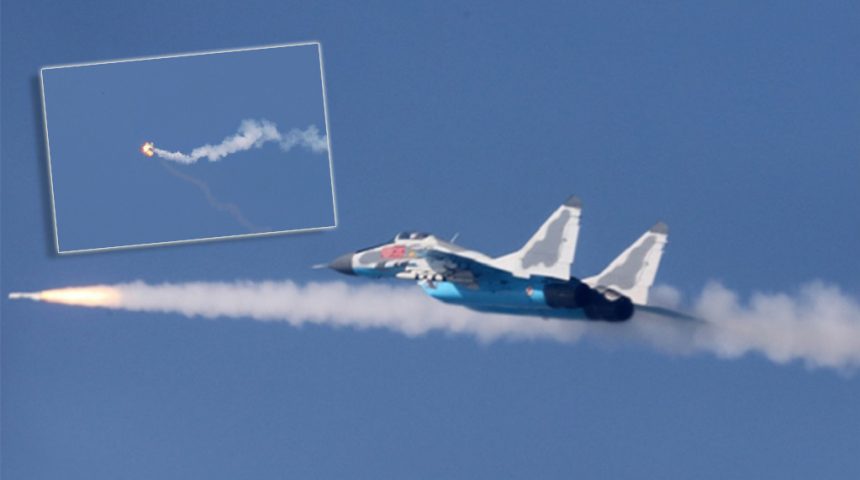The visit also provided a rare public appearance of the weapons used by North Korean aircraft.
Last week, the North Korean leader Kim Jong-Un visited an unspecified “pursuit assault plane group” where he inspected MiG-29 and Su-25 jets. Based on the available info, the visit should have happened at Sunchon Airbase, about 30 miles north of Pyongyang, where all MiG-29s and Su-25s are based. The visit provided some rare insights about the weaponry of the Korean People’s Army Air and Anti-Air Force, including what could be the first photo of a NK MiG-29 firing an R-60 IR air-to-air missile (AA-8 Aphid in NATO designation).
According to state media, the “Supreme Leader” ordered the fighters to scramble and perform air drills where they “chased, picked up and downed air targets”. It’s not sure what kind of simulated targets were used, but we can’t rule out the possibility of targets drones, as NK is reportedly developing many drones mainly for kamikaze attacks and some were even found crashed in South Korea.
#NorthKorea Kim Jong-un inspection of Mig-29 Fulcrum fighter & Su-25 Frogfoot attack aircraft at Sunchon AFB pic.twitter.com/FwYdoNQT0p
— Joseph Dempsey (@JosephHDempsey) April 11, 2020
Additionally, other than the missile’s smoke trail, photos show another smoke trail which seem departing from the ground, so we can assume that some kind of target was launched from the ground and not dropped by another aircraft like in some western air-to-air exercises where a first aircraft drops illumination flares to provide a target for the second aircraft that will then fire its IR guided missile.
The official photos of the visit show aircraft and personnel lined up the airbase’s ramps, along with some rarely seen weapons, as NK aircraft are always seen unarmed in the few available photos.
Let’s start from the Mig-29 and its R-60 and R-27 missiles.

The R-60 or AA-8 Aphid is one of the world’s lightest air-to-air missiles, with a launch weight of 44 kg (97 lb), and was one of the most agile missile before the introduction of the R-73 (or AA-11 Archer) and the AIM-9X. The IR guided missile, with a range of only 8 km (or 5 miles), was also seen in old propaganda photos from the ‘80s and in a rare cockpit footage on the Su-25, other than the MiG-29.
The other air-to-air missile showcased is a MiG-29’s exclusive, the radar guided R-27R or AA-10 Alamo-A. The missile, which uses semi-active radar homing (SARH) like the AIM-7 Sparrow, has a maximum range of 73 km or 45 miles. It’s worth noting that the missile in the photos is the standard -R version and not the -ER Alamo-C, which has an extended range.
Should point out these are not ‘new’ missiles
Kh-29L likely entered service alongside Su-25 in 1988, it just took some 30 years to see it!https://t.co/UcQe6gxJG6
— Joseph Dempsey (@JosephHDempsey) April 12, 2020
This pic.twitter.com/Renbqzdpps
— 🐔Tarao Goo@ NK Watcher🐤 (@GreatPoppo) April 12, 2020
The Su-25 weapons are at their second public appearance after the aforementioned ‘80s photos. Among those, we can see the Kh-25ML and the Kh-29ML air-to-surface missiles, the SPUU-22 gun pod and the SPS-141 ECM pod.
The Kh-25L (or AS-10 Karen) and Kh-29L (or AS-14 Kedge) are notably still used also by the Russian Air Force, as seen also in photos of the Syrian conflict. They both use semi-active laser guidance with a range of about 10 km or 5.5 miles. Their application, however, is different, as the Kh-25 with an 86 kg (190 lbs) HE warhead is used for smaller or lightly reinforced targets and the Kh-29 with a 320 kg (700 lbs) warhead is used for larger or reinforced targets.
The SPUU-22 gun pod is somewhat unique compared to western equivalents, as it uses a twin barrel GSh-23L 23 mm autocannon that can be elevated downwards up to 30 degrees, allowing the aircraft to perform a gun strafe at ground targets while in level flight, without the need to dive. Another unique feature is that the pod can be mounted also to fire backwards and strafe ground targets after overflying them.
The SPS-141 Gvozdika is the second generation of Soviet ECM pods and probably the most widespread system of this type, developed to jam the MIM-14 Nike Hercules and the MIM-23 Hawk SAM systems, both used in South Korea until some years ago. The pod was considered moderately effective during the Gulf War where it jammed Hawk batteries, forcing the US to upgrade the missile. The pod was even used on German F-4F during exercises after the country’s reunification.
Not shown in the recent photos, but known to be used by NK Su-25s, are the FAB series free fall bombs and the S-5 55 mm unguided rockets.









